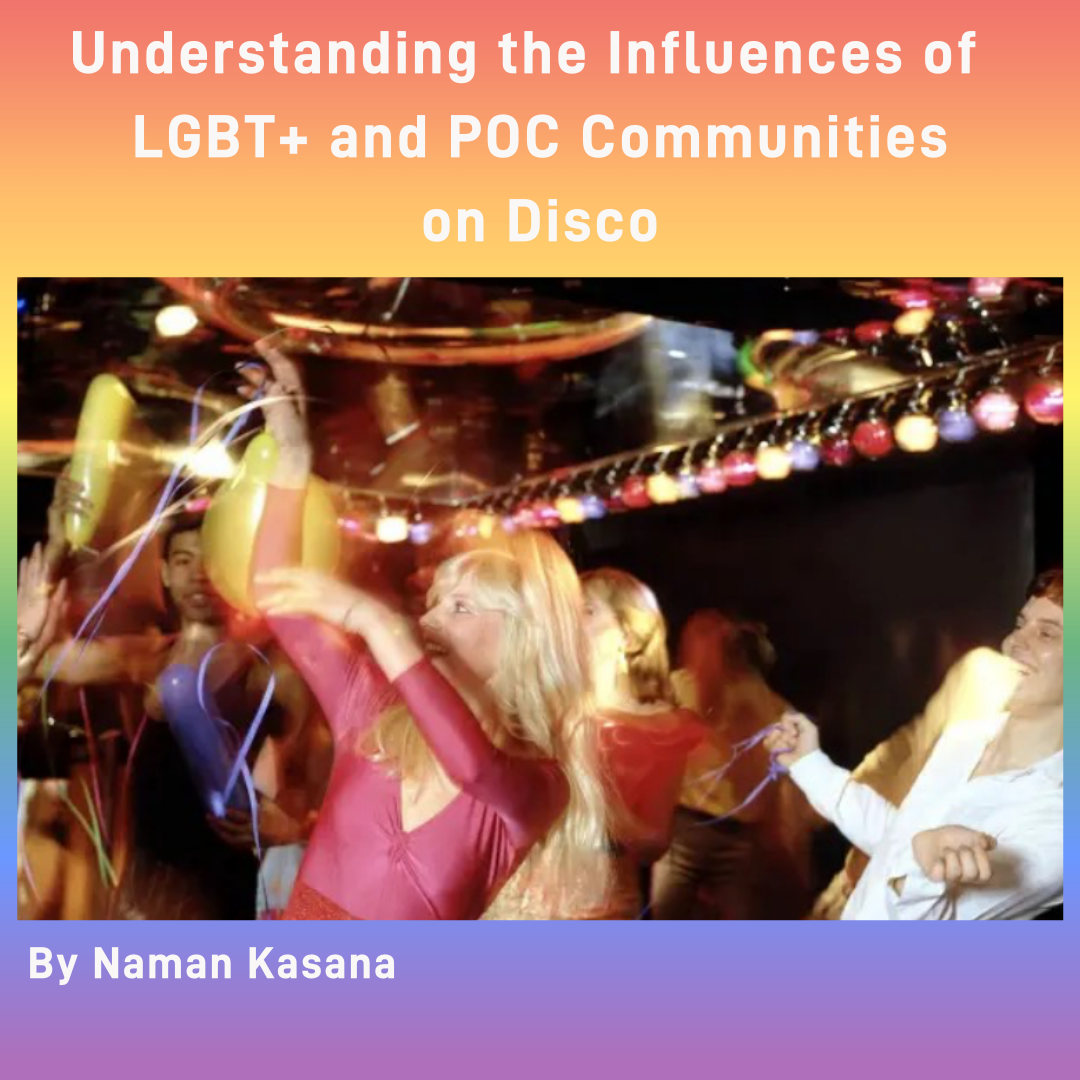
20 Jun Understanding the influences of LGBT+ and POC communities on Disco by Naman Kasana
Disco is remembered as simply being fun. It was about dancing and feeling the music in your feet rather than the heart. As a genre it started during the late 60s and it really blossomed into a cultural shift during the 70s. Although it didn’t have longevity, it did leave an impact on today’s music. You can hear its influence in today’s pop music and artists such as Doja Cat, Dua Lipa and Daft Punk. However, it has roots deeper than just the dance floor. At the time of its inception, disco was a political statement. It enabled Female, Gay, Black, Latin artists to highlight their art and music, it provided them with a platform and opportunity. It was a breakout from all the oppression these communities experienced and allowed them to simply enjoy disco and have a sense of security from the outside. Communities that were alienated for simply being themselves is how disco was born.
HISTORY OF DISCO
Disco started during the later half of the 60’s and it was influenced by the Hispanic, African American and LGBT communities of Philadelphia and New York City. The first half of the 60s was dominated by rock music. In some aspects, rock music and disco countered each other. Rock and Roll represented an era of hyper masculinity and disco allowed for representation to enter through the doors. Representation of different communities that had been marginalised but now be able to show themselves as themselves and shed light on their art.
WHAT WAS DISCO ABOUT
Disco had more going for it than simply entertainment. Even though that was a big part of what disco was, it represented something more powerful. Before Disco blossomed into a cultural shift for the world, there were a few things that were leading to that change. That being the civil rights movement and the Stonewall riot. The civil rights movement took place from 1954 – 1968 and it was to abolish racial segregation and discrimination throughout the United States. Stonewall took place in 1969 in New York by the gay community in response to a police raid. They were quite monumental events in defining what disco was about and what it represented. For instance, before the Stonewall Riots the idea was to stay invisible. Gay bars didn’t allow gay people to dance together. A lot of the bars and clubs were segregated for people on the basis of their colour. The increasing race riots and homophobia of the 1960s led to unsafe spaces for people of color and members of the gay community. This was the kind of oppression these communities experienced,and when they didn’t have a place to go to, they made their own. That’s how disco was born- for people who didn’t feel accepted in the “normal” world so they created a dance floor for themselves.
Disco was quite different for its time as it didn’t have the “male” sound (or at least what was considered to be the male sound). Coming from Rock and Roll, disco had quite a different aesthetic from the former, which was also quite obvious to the rock ’n’ roll fans. Disco was about the female sound. This doesn’t mean there weren’t male artists but even they had a different character to their voice and artistry which blended in with disco. Still the female artists ruled the era from Donna Summer, Gloria Gaynor, Grace Jones and Sister Sledge– these women defined disco and its music.
THE ROLE OF QUEER CULTURE AND POC ON DISCO
The queer culture and people of colour had a lot of influence in the growth and spread of disco. When we think of disco we think of dancing to the groove, it’s interesting to know that a lot of the dances for disco were influenced by the hispanic community. A lot of the influences for disco moves were latin dances such as samba, cha cha and tango. These dances exude a sense of freedom, fun, energetic and inclusive. These dances required you to find someone to dance with in a time when dancing with someone wasn’t a possibility for many and they gave a sense of community.
The fashion during the 70s was quite iconic as well. Before disco, a lot of the norms for men and women had been set beforehand in terms of their looks and aesthetics. However, disco gave a sense of queerness and androgyny when it came to fashion choices. When it came to 70’s artists such as Prince, David Bowie, Michael Jackson, Grace Jones, Elton John and Madonna everything was exaggerated, unique and a little hippie. Disco was also quite popular in the Ballroom scene. Ballrooms were started by the queer community where they would have the opportunity to host extravagant shows. People would walk down categories, dressed to fit the picture they had of themselves in their mind while disco was playing in the background. Disco was alive in these ballrooms and clubs and people walked in dressing up in flamboyant and vibrant outfits to feel confident, loved and celebrated for being themselves, something they lacked outside those doors.
Studio 54, which is quite the famous club in New York was actually inspired by the gay bars and African American clubs. It was a havan for inclusitivity and acceptance for queer and people of colour. It became such a massive thing that famous celebrities would come to this shady place in New York just to have fun. There would be massive lines for entry in the club, they prioritised queer and trans people for entry – they wanted the space to be filled with people who were interesting and different, not just the boring and rich. Trans women of colour were welcomed and celebrated in the club and made to feel safe.
UNDERSTANDING DISCO’S INFLUENCE IN INDIA’S CONTEXT
India is no stranger to understanding the wilderness that exists when it comes to disco. We’ve had a childhood where disco was quite the thrill on television. Disco came to India after it had started to diminish in the west in terms of its popularity. Initially, there was a mention of how “disco was simply fun” which later was elaborated to better understand the west’s ideology and political views. However in India, it’s the former that is the truth. Disco was simply a fun trend in India which to an extent still continues to shine through every now and then.
When it comes to the disco scene in India, topics of sexuality and racism weren’t necessarily the focal point. India wasn’t having a Stonewall, a lot of the talks about the community were almost non-existent and so were topics about people of colour. Therefore, when disco arrived, it was all about dance moves, funky clothes and music. Disco arrived in Bollywood through movies. In the 80s came out “Qurbani” and the track “Aap Jaisa Koi” definitely laid the foundation for what would be considered the disco era. Bollywood was doing what Bollywood always did, pick up a trend and make it its own.
Bollywood did stick to the disco aesthetics as well which were the blinking lights, colourful dance floors, glittery attire, flared bell bottoms, shiny headbands and synth heavy voices. Disco gave a platform for many actors and singers. The “disco dancer” Mithun, became famous for his disco moves. This was considered the era for Asha Bhosle, who was popular for her seductive and melodious voice and Bappi Lahiri who gave his voice for many iconic disco tracks. Bollywood at the time understood the assignment. They saw what was happening in the west and they made it their own. Bollywood has tried to bring a lot of these iconic tracks back with remixes and remakes but it hardly matched the grandeur of the 80s.
CONCLUSION
Disco was a movement that gave people hope and courage to be themselves. A majority of these artists found themselves and their sound through disco. It was a powerful political statement during times where riots were happening regarding race and sexuality. Disco brought these taboo subjects to the forefront. It was a breakout from all the oppression these communities experienced and allowed them to simply enjoy disco and have a sense of security from the outside.
Women, POC and the Queer community were the driving factors of disco and considering the oppression that these communities were under, it is clear why “Disco Sucks” started. During the demolition in Chicago, many people mentioned how some of the discs being burned weren’t even disco but just by black and female artists. It created a contrast for what was prior to disco, Rock ‘n’ Roll and many found that to be quite threatening as disco was changing what it meant to be a man during the 70s. It was highlighting women and their sound and there was a queerness about it that seemed alarming to the public. Eventually disco went to be the underground scene it was before the popularity surge.
The 70s will always be remembered for the funky moves of disco, the blinding lights, the artistry, the fashion, the music and the dance floor. It will always be the pivotal point in history in terms of giving space to different communities and groups of people to showcase their talents. Disco’s spirit was fun and exciting for the public and continues to be. It had meaning beyond anyone’s recognition.
Written by Naman Kasana
BIBLIOGRAPHY
https://homegrown.co.in/article/803651/how-disco-took-india-by-storm-in-the-glorious-80s https://www.worldatlas.com/articles/what-was-disco-dance-music-and-where-did-it-begin.html https://www.nytimes.com/2016/11/19/nyregion/david-mancuso-dead-the-loft.html
https://www.theguardian.com/music/2016/nov/15/david-mancuso-the-loft-egalitarian-utopia https://nexus.radio/news/the-history-of-disco
https://www.bbc.com/culture/article/20180403-why-disco-should-be-taken-seriously
https://guides.library.berklee.edu/ld.php?content_id=55770938
https://guides.library.berklee.edu/ld.php?content_id=56237567
https://www.youtube.com/watch?v=LO_EF1BY6Tg
https://www.youtube.com/watch?v=r1ZHez_q_V4
https://www.theguardian.com/music/2016/nov/15/david-mancuso-the-loft-egalitarian-utopia https://www.npr.org/2020/02/19/807333757/still-saving-the-day-the-most-influential-dance-party-in-history-turns-50 https://www.spin.com/2016/11/remembering-david-mancuso-new-york-disco-pioneer-and-founder-of-the-loft/ https://www.buzzfeed.com/gabrielsanchez/pictures-that-show-just-how-crazy-1970s-disco-really-was







No Comments